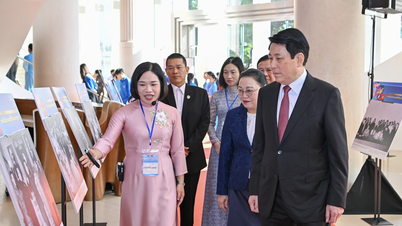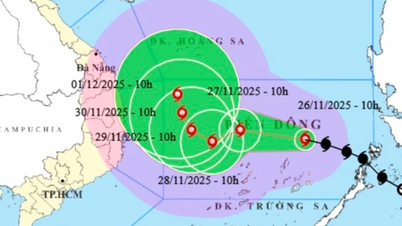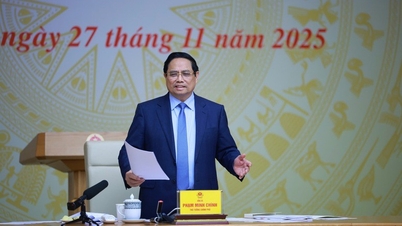The three options proposed by the Ministry of Education and Training all have their own arguments, but reality and time are putting the education sector before a problem that requires a solution that is both effective and feasible, while avoiding policy risks that have caused concern to society.
The option of selecting a unified set of textbooks for each grade level based on the three current sets of textbooks - that is, each grade level uses a set of textbooks that have been assessed and implemented in practice - is receiving the highest consensus. Not only because of its reasonableness, but also because this is the only option that can be implemented promptly, ensuring stability and not causing major disruptions in the entire education system.
Reduce waste, increase efficiency
In the parliament or in the corridor of the Dien Hong meeting room, some National Assembly delegates emphasized that this plan "ensures continuity, efficiency, savings and prevents waste". These opinions reflect the reality that schools have had to face for many years: each textbook change entails huge costs for training, plan adjustment, equipment purchase, and especially the financial burden on parents.
From a practical perspective, the Principal of To Hien Thanh Primary School (Hanoi) - Ms. Pham Phuong Lien said that the constant change of textbooks has created a cycle of overload for teachers: every year they have to get used to a new set of books, new training, new lessons. She emphasized that "if we start writing a new set of books from scratch, the entire system will have to go through an unprecedented and extremely costly training period". The perspective of a leader shows that the pressure to retrain teachers cannot be ignored.
When reporters contacted many schools in Hanoi, Quang Tri, An Giang, Binh Dinh, they also noted a common reality: teachers are familiar with the current textbooks, and even use many sets in parallel during the teaching process. If they continue to write a completely new set of books, the education sector will have to pay a huge "tuition fee", while the social resources poured into the three current textbooks are undeniable.
Not re-establishing monopoly, but still ensuring unity
What worries many teachers most when discussing the option of “choosing only one set” is the risk of returning to the textbook monopoly mechanism - which existed for decades before the implementation of the socialization policy. Vice Principal of Lam Thuy Primary and Secondary School (Quang Tri), Mr. Ngo Mau Tinh, commented that if only one set of textbooks were chosen from the current sets, it would “go against the spirit of innovation and eliminate the creative motivation of other groups of authors”. Sharing the same view, many experts affirmed that the diversity in educational philosophy and lesson organization of the three sets of books is a valuable asset, which should not be eliminated just for the sake of unification.
According to experts, organizing a unified set of textbooks by grade level therefore becomes the optimal compromise because: Each grade level still has a single set of books, ensuring the necessary consistency. All three publishers have the opportunity to contribute, avoiding monopoly or "losing" investment capital. Schools and teachers at each level only have to get acquainted with a complete set of textbooks, without confusion. This is the key point that helps this solution both achieve stability and maintain healthy competition - something that an open, modern education system must aim for. Moreover, this solution also ensures feasibility in both quality and time.

One of the outstanding advantages of the "choose by grade level" option is the ability to create a coherent knowledge chain throughout each grade - something that teachers consider to be much more important than unifying grades 1 to 12 with the same set of books.
Teacher Ho Quy Nghia, Minh Phu High School, Kim Anh Commune (Hanoi) shared that each set of books today has its own strengths, but "you cannot take one set and leave the other", because all have been evaluated and tested in practice. From many years of teaching experience, he affirmed that most teachers tend to choose the option of "choosing one set for each level", instead of combining lessons from many sets to write a new set.
When analyzed further, it is argued that the unification by grade level also brings a great advantage: ensuring consistent pedagogical methods.
In a complete set of books, from the lesson structure, the system of illustrations, the logic of implementation to the assessment method are all designed synchronously. This helps students not to be "distracted", teachers do not have to constantly adjust teaching methods when changing classes, and schools can easily organize professional activities in depth.
Fair to publishers and stable for society
The option of choosing by level of education creates a fair space - something that the whole society is concerned about. Some delegates said that this is the only way to ensure that "no subject is considered major or minor, no publisher is left out". When reporters talked with book publishers, many businesses said that they had invested heavily in accordance with the policy of socializing textbooks from Resolution 88. If they are now completely eliminated, the financial loss will push them into bankruptcy, leading to significant consequences.
The education sector has spent a decade trying to eliminate textbook monopoly; therefore, choosing by grade level is the most reasonable way to maintain competition but avoid extremes.
From a management perspective, this plan also helps the Ministry of Education and Training significantly simplify the process of assessment, training, and professional guidance. Ms. Pham Phuong Lien analyzed that if each level of education uses a set of textbooks, the organization of training will become unified, and there will no longer be the current situation of "one province with three sets, one district with three styles". This allows teachers to improve their expertise more deeply instead of constantly chasing new books.
Furthermore, when all levels of education use one set of textbooks, the Departments of Education and Training can also develop more effective educational plans, avoiding patchwork. Stability in educational administration is the foundation for sustainable teaching and learning quality.
Most importantly, as many teachers insist, all changes must be for the benefit of the students. Every time a book is changed, children must adapt again, even “relearn how to learn”. Especially in primary school, this disruption can create unnecessary pressure.
The level-based plan not only saves money for parents but also provides academic stability for students, helping them access knowledge in a seamless, uninterrupted, and non-disruptive manner between classes.
In the context of many challenges in the education sector, choosing a reasonable, balanced and humane policy is a measure of state governance capacity. This option meets three requirements at the same time: legality, practice and social expectations.
Choose a viable solution to stay ahead of the curve
There is less than a year left until the 2026-2027 school year - too short a time to compile a completely new set of textbooks but just enough time to complete the plan to select textbooks by grade level.
This is not only a technical solution, but also a strategic policy choice, ensuring the successful implementation of Resolution 71, avoiding monopoly risks, protecting social resources and aiming at the highest interests of learners.
This plan also shows flexible educational management thinking, knowing how to inherit, knowing how to analyze right and wrong from practice and knowing how to put the stability of the system first.
With the above arguments, it can be affirmed that choosing a unified set of textbooks by grade level is the most reasonable, feasible and humane solution in the current period - and is the best solution for the education sector to not miss a beat in the face of the country's strong innovation requirements.
National Assembly Delegate VU HONG LUYEN (Hung Yen):
I think this is a reasonable solution.
Regarding the content related to organizing a unified set of textbooks, opinions are focusing on the following three basic options: 1- Organizing the compilation of a completely new set of textbooks; 2- Choosing one of the three existing textbook sets as a common set; 3- Choosing a unified set of textbooks by grade level based on the three current textbook sets . Each option has its own advantages and limitations and needs to be discussed and carefully considered.

Through practical research and absorbing the opinions of many experts, I believe that the option of choosing a unified set of textbooks for each level of education is a reasonable and feasible option that fully meets the requirements of the law as well as the major orientations of the Party and State as expressed in the Constitution, resolutions of the Politburo, the Government and the National Assembly.
Firstly , this solution ensures continuity, efficiency, savings and prevents waste. Using a common set of books for each level of education helps to overcome the situation of constant change and conversion, which is costly for families, schools and the education system itself.
Second , the plan of a unified set of books ensures consistency throughout the system. When the goals and requirements of the general education program are conveyed uniformly through a set of books at each level, teachers will have a solid basis for implementing teaching methods; students will have access to consistent content; and schools will have less pressure to choose, avoiding the situation of "each person choosing for themselves" causing a quality gap between localities. At the same time, in each complete set of books of any publisher, the content and teaching methods have been designed synchronously and consistently, thereby improving the effectiveness of program implementation.
Third , this is a solution to ensure fairness between organizations, individuals and between subjects. All textbooks that have been assessed and approved have the opportunity to be selected at at least one level of education, in line with the spirit of encouraging socialization of Resolution 88. Enterprises, especially private enterprises that have invested large resources in compilation work, will not fall into a situation of losing all capital, leading to the risk of bankruptcy. At the same time, this method also avoids the situation of distinguishing between main and secondary subjects, or the situation where some subjects have books selected at all levels while other subjects have no books selected; or distinguishing between exam subjects and non-exam subjects, subjects with many periods and subjects with few periods.
Another important thing is that the plan for a unified set of textbooks by grade level helps to increase convenience and efficiency in state management of education. The Ministry of Education and Training does not have to organize the appraisal and selection of too many books; at the same time, the work of directing, guiding and training teachers will be more scientific, focused and effective, because each set of books is associated with a clear and unified compilation unit.
Choosing a unified set of textbooks for each level of education is not only a technical solution but also an important step to ensure fairness, quality and sustainability of educational innovation. I respectfully request the National Assembly, the Government and the Ministry of Education and Training to continue researching and perfecting this plan in a rigorous, transparent and practical manner.
Source: https://tienphong.vn/mot-bo-sach-giao-khoa-thong-nhat-giai-phap-nao-kha-thi-nhat-post1799551.tpo





![[Photo] President Luong Cuong attends the 50th Anniversary of Laos National Day](/_next/image?url=https%3A%2F%2Fvphoto.vietnam.vn%2Fthumb%2F1200x675%2Fvietnam%2Fresource%2FIMAGE%2F2025%2F11%2F27%2F1764225638930_ndo_br_1-jpg.webp&w=3840&q=75)
![[Photo] Prime Minister Pham Minh Chinh chairs the 15th meeting of the Central Emulation and Reward Council](/_next/image?url=https%3A%2F%2Fvphoto.vietnam.vn%2Fthumb%2F1200x675%2Fvietnam%2Fresource%2FIMAGE%2F2025%2F11%2F27%2F1764245150205_dsc-1922-jpg.webp&w=3840&q=75)



































































































Comment (0)